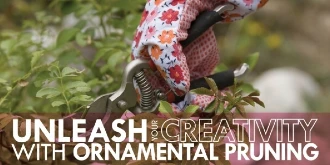Unleash Your Creativity with Ornamental Pruning
A little nip here and a little tuck there can transform your shrubs into botanical garden wannabes. If you have an artistic eye and a creative touch, you can elevate utilitarian pruning to ornamental masterpieces. Whether your preference is for a formal look or you want a whimsical touch, your garden can be a custom-designed reflection of your personality that greets your guests before you open the front door.

Timing is Critical
If you want to transform a fruit tree into a work of art or a flowering shrub into a flurry of blossoms, pruning certain plants at the wrong time of year can prevent them from producing flowers or fruits. So if you have questions about the proper timing, ask The Grounds Guys® for basic advice of when to prune which plant before unleashing your creative botanical potential.
Two-Dimensional Espaliers
If you're short on garden space, you can train some plants to grow against a wall, fence or lattice. Some espaliered designs are intricate, such as basket-weave patterns, while other designs are simple shapes that include fans and candelabras. Some suitable plants for espaliers are fruit trees and shrubs that produce berries, such as hollies (Ilex spp.) and firethorn (Pyrecantha spp.). You can even train a redbud tree (Cercis spp.) into an espaliered shape to feature its pink blossoms that bloom before the tree leafs out in spring.
Choose a plant that has pliable new growth, which you can easily bend into shape and secure onto a support until the new growth hardens and holds its shape. You'll want to prune all the branches except the framework that forms the shape you want. Simply tie these branches onto a support, securing them in strategic places to form the shape you'd like.
Three-Dimensional Topiaries
You can use purchased wire topiary forms, or if you have a steady hand and an artistic eye, you can prune plants freehand into desired shapes. Suitable plants for topiaries are the quintessential boxwood (Buxus spp.), English ivy (Hedera helix) and rosemary (Rosmarinus officinalis). If you use a topiary form, you can secure it to the ground or position it in a container. English ivy, which tends to be invasive, is easily contained as a potbound topiary. Cover a topiary form with chicken wire or hardware cloth and line the inside with damp sphagnum peat moss. Fill the inside of the form with potting soil and use ties to secure the edges of the wire to the form. Gently press the rootballs of your chosen plants through the wire mesh, and if the mesh is too small, use tin snips to open up an area that's large enough. As a reflection of your personality, you can use a formal topiary form, such as an obelisk, or a whimsical one that's formed into an animal shape. As the plants grow, secure them to the wire with floral pins or ties until the topiary form is covered with greenery. Then it's a simple matter of pruning the plants by snipping or shearing to keep a tidy topiary.
Living Sculptures
The sizes, shapes and designs of your ornamental pruning creations are limited only by your preferences and your skill in creating them. The Grounds Guys will leave the inspiration to you, but we'll be on standby to answer all your horticultural questions about which plants to choose, when to prune them and how to keep them properly watered and fertilized. So give ornamental pruning a try and let us know if we can help!
 Click to call
Click to call


